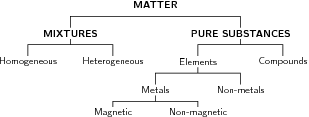| << Chapter < Page | Chapter >> Page > |
All the objects that we see in the world around us, are made of matter . Matter makes up the air we breathe, the ground we walk on, the food we eat and the animals and plants that live around us. Even our own human bodies are made of matter!
Different objects can be made of different types of matter, or materials . For example, a cupboard (an object ) is made of wood, nails and hinges (the materials ). The properties of the materials will affect the properties of the object. In the example of the cupboard, the strength of the wood and metals make the cupboard strong and durable. In the same way, the raincoats that you wear during bad weather, are made of a material that is waterproof. The electrical wires in your home are made of metal because metals are a type of material that is able to conduct electricity. It is very important to understand the properties of materials, so that we can use them in our homes, in industry and in other applications. In this chapter, we will be looking at different types of materials and their properties.
The diagram below shows one way in which matter can be classified (grouped) according to its different properties. As you read further in this chapter, you will see that there are also other ways of classifying materials, for example according to whether or not they are good electrical conductors.

We see mixtures all the time in our everyday lives. A stew, for example, is a mixture of different foods such as meat and vegetables; sea water is a mixture of water, salt and other substances, and air is a mixture of gases such as carbon dioxide, oxygen and nitrogen.
A mixture is a combination of two or more substances, where these substances are not bonded (or joined) to each other.
In a mixture, the substances that make up the mixture:
Some other examples of mixtures include blood (a mixture of blood cells, platelets and plasma), steel (a mixture of iron and other materials) and the gold that is used to make jewellery. The gold in jewellery is not pure gold but is a mixture of metals. The amount of gold in the jewellery is measured in karats (24 karat would be pure gold, while 18 karat is only 75% gold).

Notification Switch
Would you like to follow the 'Siyavula textbooks: grade 10 physical science' conversation and receive update notifications?